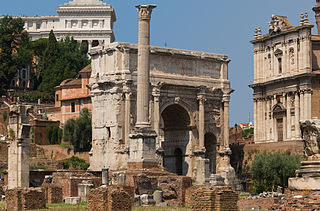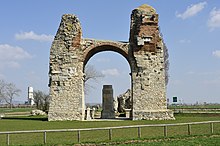
Carnuntum was a Roman legionary fortress and headquarters of the Pannonian fleet from 50 AD. After the 1st century, it was capital of the Pannonia Superior province. It also became a large city of 50,000 inhabitants.

A triumphal arch is a free-standing monumental structure in the shape of an archway with one or more arched passageways, often designed to span a road. In its simplest form a triumphal arch consists of two massive piers connected by an arch, crowned with a flat entablature or attic on which a statue might be mounted or which bears commemorative inscriptions. The main structure is often decorated with carvings, sculpted reliefs, and dedications. More elaborate triumphal arches may have multiple archways.

Glanum was an ancient and wealthy city which still enjoys a magnificent setting below a gorge on the flanks of the Alpilles mountains. It is located about one kilometre south of the town of Saint-Rémy-de-Provence.

The Arch of Septimius Severus at the northwestern end of the Roman Forum is a white marble triumphal arch dedicated in 203 A.D. to commemorate the Parthian victories of Emperor Septimius Severus and his two sons, Caracalla and Geta, in the two campaigns against the Parthians of 194-195 A.D. and 197–199 A.D. After the death of Septimius Severus, his sons Caracalla and Geta were initially joint emperors. Caracalla had Geta assassinated in 212 A.D.; Geta's memorials were destroyed and all images or mentions of him were removed from public buildings and monuments. Accordingly, Geta's image and inscriptions referring to him were removed from the arch.

Volubilis is a partly-excavated Berber-Roman city in Morocco situated near the city of Meknes that may have been the capital of the Kingdom of Mauretania, at least from the time of King Juba II. Before Volubilis, the capital of the kingdom may have been at Gilda.

The Arch of Hadrian, most commonly known in Greek as Hadrian's Gate, is a monumental gateway resembling—in some respects—a Roman triumphal arch. It spanned an ancient road from the center of Athens, Greece, to the complex of structures on the eastern side of the city that included the Temple of Olympian Zeus.

Hadrian's Gate is a triumphal arch located in Antalya, Turkey, which was built in the name of the Roman emperor Hadrian, who visited the city in the year 130 CE. It is the only remaining entrance gate in the walls that surround the city and harbor.

The Umbilicus Urbis Romae —"Navel of the City of Rome"—was the symbolic centre of the city from which, and to which, all distances in Ancient Rome were measured. It was situated in the Roman Forum where its remnants can still be seen. These remains are located beside the Arch of Septimius Severus and the Vulcanal, behind the Rostra. Originally covered in marble, the Umbilicus is now a forlorn-looking brick core some 2 metres high and 4.45 metres in diameter.

Laodicea was a port city and important colonia of the Roman Empire in ancient Syria, near the modern city of Latakia. It was also called Laodicea in Syria or Laodicea ad mare. Under Septimius Severus, it was the capital of Roman Syria, and of the Eastern Roman province of Theodorias from 528 to 637 AD.

Petronell-Carnuntum is a community of Bruck an der Leitha in Austria. It is known for its annual World Theatre Festival.

A tetrapylon, plural tetrapyla, known in Latin as a quadrifrons is a type of ancient Roman monument of cubic shape, with a gate on each of the four sides, generally built on a crossroads.

Porta Sempione is a city gate of Milan, Italy. The name is used both to refer to the gate proper and to the surrounding district (quartiere), a part of the Zone 1 division, including the major avenue of Corso Sempione. The gate is marked by a landmark triumphal arch called Arco della Pace, dating back to the 19th century, although its origins can be traced back to a gate of the Roman walls of Milan.

The Princes' Gates is a triumphal arch and a monumental gateway at Exhibition Place in Toronto, Ontario, Canada. Made out of cement and stone, the triumphal arch is flanked by colonnades on both of its sides, with curved pylons at both ends. The 350-foot-long (110 m) structure serves as the eastern gateway to the Canadian National Exhibition, an annual agricultural and provincial fair held at Exhibition Place.

The Great Colonnade at Palmyra was the main colonnaded avenue in the ancient city of Palmyra in the Syrian Desert. The colonnade was built in several stages during the second and third century CE and stretched for more than a kilometer. It linked the Temple of Bel, in the southeastern end of the city, to the West Gate and the Funerary Temple in the northwestern part.

The Arch of Caracalla is a tetrapylon Roman triumphal arch in Thebeste, located in present-day Tébessa, Tébessa Province, Algeria. It was constructed during the early 3rd century.

The Arch of Septimius Severus is a triumphal arch in Leptis Magna, located in present-day Libya. It was commissioned by the Libya-born Roman Emperor Septimius Severus. The arch was in ruins but was pieced back together by archeologists after its discovery in 1928.

The Eastern gate of Philippopolis is one of the three entrances of the ancient city that have been discovered in Plovdiv. The gate was built on the main road to Byzantium and the Bosphorus. Initially constructed in the 2nd century AD during the reign of Hadrian, the gate and the complex around it were completely rebuilt in the 4th century, and partially repaired in the 5th century. The Eastern gate was discovered in the 1970s.

The Latakia Tetraporticus, also sometimes referred to as the Triumphal Arch of Septimius Severus is a triumphal arch located in modern-day Latakia, Syria in the south-east region of the city, in the Port Said street. Believed to be built in honour of Roman emperor Septimius Severus, the arch dates to 183 AD and is considered a symbol of the city.

The Porte Noire is a Roman triumphal arch in Besançon, France.




















